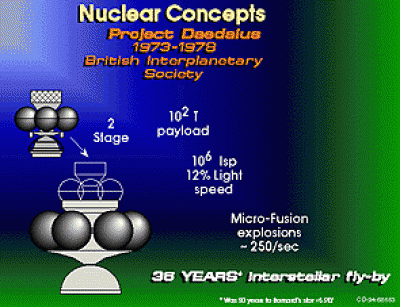“Fusion reactors powered by deuterium/helium-3 are a good candidate for a very advanced spacecraft propulsion. The fuel has the highest energy-to-mass ratio of any substance found in nature, and, further, in space the vacuum the reaction needs to run can be had for free in any size desired. A rocket engine based upon controlled fusion could work simply by allowing the plasma to leak out of one end of the magnetic trap, adding ordinary hydrogen to the leaked plasma, and then directing the exhaust mixture away from the ship with a magnetic nozzle. The more hydrogen added, the higher the thrust (since you’re adding mass to the flow), but the lower the exhaust velocity (because the added hydrogen tends to cool the flow a bit). For travel to the outer solar system, the exhaust would be over 95 percent ordinary hydrogen, and the exhaust velocity would be over 250 km/s (a specific impulse of 25,000 s, which compares quite well with the specific impulses of chemical or nuclear thermal rockets of 450 s or 900 s, respectively). Large nuclear electric propulsion (NEP) systems using fission reactors and ion engines, a more near-term possibility than fusion, could also achieve 25,000 s specific impulse. However, because of the complex electric conversion systems such NEP engines require, the engines would probably weigh about eight times as much as fusion systems and, as a result, the trips would take twice as long. If no hydrogen is added, a fusion configuration could theoretically yield exhaust velocities as high as 15,000 km/s, or 5 percent the speed of light! Although the thrust level of such a pure D-He3 rocket would be too low for in-system travel, the terrific exhaust velocity would make possible voyages to nearby stars with trip times of less than a century.”
Robert Zubrin, Entering Space: Creating a Spacefaring Civilization (New York: Jeremy P. Tarcher/Putnam, 1999), p. 161.

Centauri Dreams note: As far as I know, the first suggestion that helium-3 be used in an interstellar mission came from the Project Daedalus team in the 1970’s. Deuterium/tritium is thought to be an easier reaction to initiate, but working with helium-3 offered a significant benefit: the reaction yields protons and alpha particles that can be shaped by a magnetic nozzle, rather than neutrons, which a magnetic field cannot influence. The mission would be composed of two stages, the first burning for two years, the second for almost as long, before the long coast to destination.
Image: The Project Daedalus design. Credit: NASA/Glenn Research Center.
Today, Daedalus stands as a reminder of the era of mammoth starship thinking. The probe’s earliest designs called for a 450 ton probe with a reaction chamber some 330 feet in diameter; even with scaling to a multi-stage design, the entire mission demanded fifty billion fuel pellets, calling for 30,000 tons of helium-3 and 20,000 tons of deuterium. As for helium-3 in such quantities, the designers recommended mining the atmosphere of Jupiter.
Zubrin discusses how such mining might take place in Entering Space. The enabling technology would be a winged craft that Zubrin calls a Nuclear Indigenous Fueled Transatmospheric (NIFT) vehicle. A NIFT would either separate out the helium-3 as it moved through the atmosphere of a gas giant, or else rendezvous in the atmosphere with an aerostat station. It would have the capability of delivering its helium-3 cargo to an orbiting fusion-powered tanker that would, in turn, take it to the inner Solar System.

